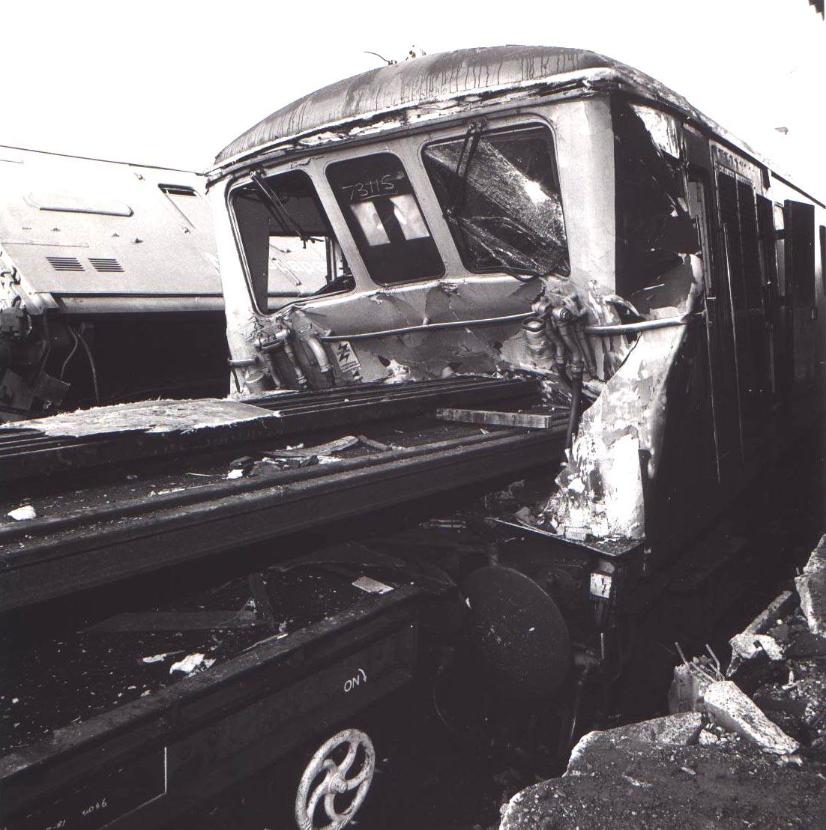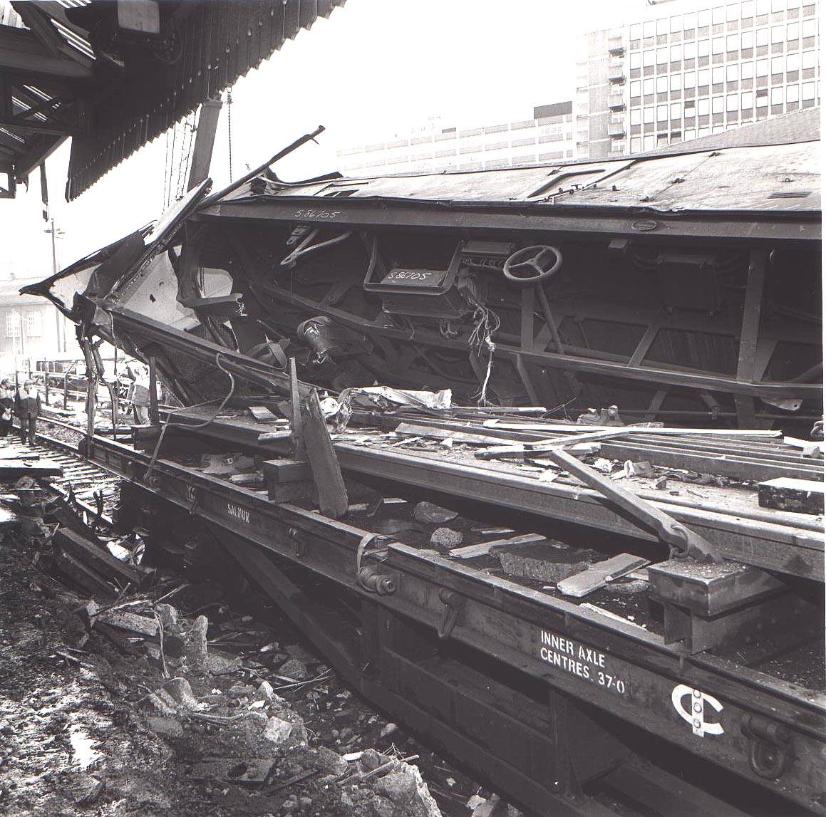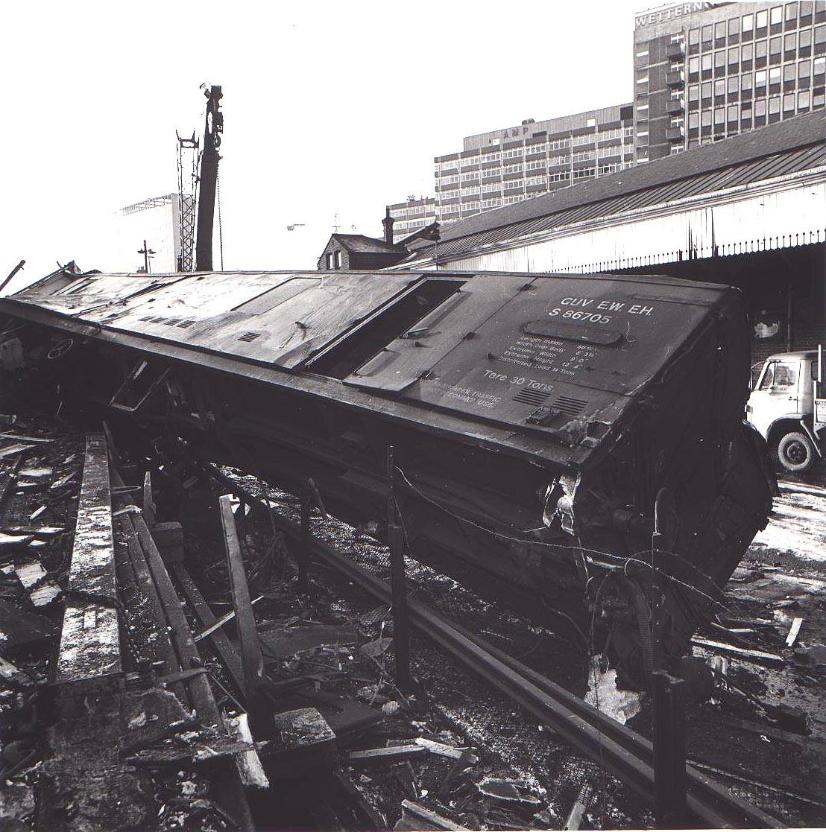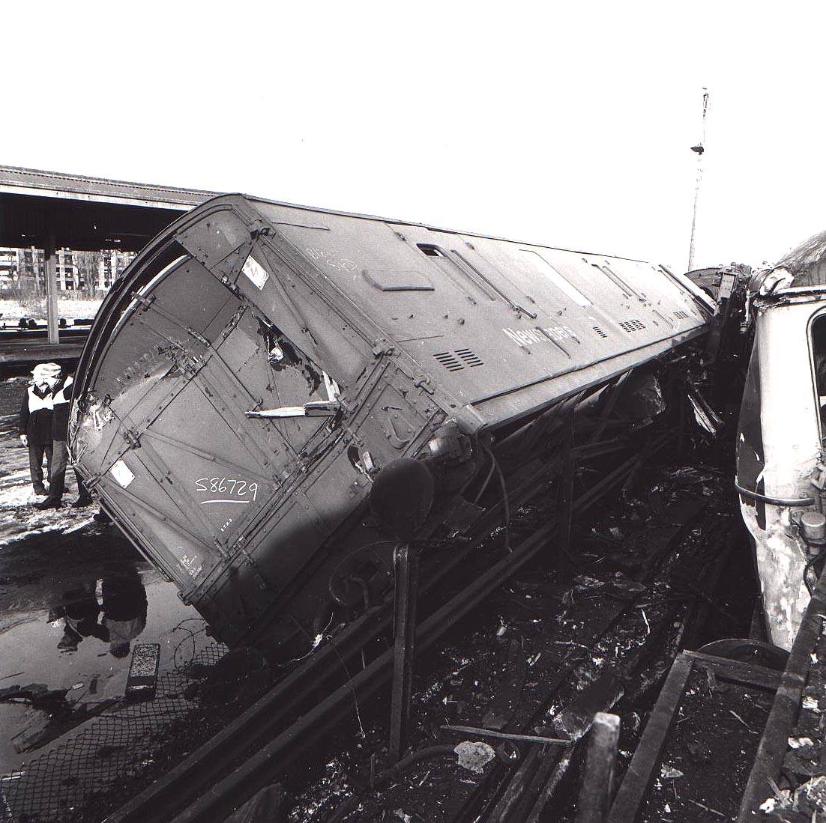
1982
EAST CROYDON TRAIN CRASH
SATURDAY 16th JANUARY 1982
INVOLVING
NORWOOD
DRIVER STEVE WALTON & SECONDMAN NICK ROWLES
& BRIGHTON M.T. DRIVER BERNIE HAYNE
Extracted & adapted from the report by
Major A.G.B. KING

ANDY GIBBS COLLECTION
A collision between an engineers train and a mail and parcels train that occurred at 01.23 on Saturday 16th January 1982 in East Croydon Station in the Southern Region British Railways. As the 23.18 (15th January) mail and parcels train from Brighton to London Bridge was standing at Platform I at East Croydon while station duties were carried out, it was run into violently at the rear by the 00.22 Three Bridges to New Cross Gate Civil Engineers Departmental freight train which had passed at Danger the protecting 4 aspect colour light signal CW3.
The rear three vans of the mail and parcels train were derailed and severely damaged as were the locomotive and the first 5 vehicles of the engineer’s train. The platform canopy and coping stones were damaged in the areaof thecollision. The driver of the engineer's train was trained in the wreckage of the locomotive cab until 08.45 when, despite strenuous efforts on the part of the Fire Brigade part of one leg had to be amputated in order to release him. The guard of the engineer's train, a member of the platform staff, and 6 Post Office employees attending the mail train suffered slight injuries. The traction current was discharged
in the course of the accident.
The emergency services were on the site within 6 minutes of being summoned. The line was re-opened at 22.30 on Sunday 17th January 1982. At the time of the accident it was dark, and freezing and there was some snow on the ground. The platform lighting at East Croydon was illuminated as were street lamps in the area.
DESCRIPTION
The Site and Signalling
I . The track and signalling described in the following paragraphs is as existing at the time of the accident. It was replaced in April 1984 by an altered track layout and new signalling controlled from Three Bridges Signal Box. East Croydon lies on the London (Victoria and London Bridge) to Brighton line 16.5km from Victoria. Redhill Station is 33.8km from Victoria, and the line lies generally north/south. Northwards from Redhill Station towards London (the Up direction) there are two tracks as far as Coulsdon South whence there are four tracks to South Croydon Signal Box (CV), which lies to the south of the station on the
east side of the line. There are then five tracks through South Croydon Station towards East Croydon. Reading from west to east, they are the up and Down Local, Up and Down Through, and the Reversible. At the London end of South Croydon Station platforms there are double crossovers allowing trains to run from the Up Through to the up Local and from the Down Local to the Down Through lines. All the lines are electrified on the third rail system at 750V d.c.
2. Between South and East Croydon there are four overbridges carrying from south to north, Coombe, Barclay, Hazledean and Addiscombe Roads. Between Barclay and Hazledean Road Bridges the Up Local enters a left hand curve with a retaining wall to the left facing in the direction of running. Under Addiscombe Road bridge the curvature reverses and Platform1 lies to the right on a right hand curve with a fence and open car park to the left. Just to the south of Addiscombe Road bridge a facing connection from the Up Through leads to the Up Loop forming a sixth track through East Croydon Station. East Croydon Signal Box (CW) is on the west side of the line some 20m to the north of the London end of the platforms. The lines rise at a gradient of l in 265/270 from Redhill to a summit between Merstham and Star Bridge Signal Boxes and then fall at 1in 263to South and East Croydon.
3. The maximum permitted speed of a Class 6 train was 45 mile/h to South Croydon, 30 mile/h over the crossovers, 40 mile/h from thereon, and 30 mile/h from a point between Barclay and Hazledean Road bridges through East Croydon on the Up Local.
4. Trains are signalled under the Track Circuit Block Regulations and controlled by 4-aspect colour-light signals with 3-lamp junction indicators at the junctions. At the time of the accident none of the signals was equipped with AWS, but work had commenced on the re-signalling of the Brighton line and this had led to certain track connections and signals being put out of use. Work had begun on wiring and the erection of new signals.
6. The sequence of signals applying to both trains was as follows at the time of the accident:
CV 25 Approaching South Croydon Station. 684m to:
CV 21/22 South Croydon Up Through Starting signal with a junction indicator for a route over the crossover to the Up Local.
When a route is set to the Up Local, the signal is approach-controlled by occupation of the berth track circuit. 501m to:-
CW 1 On the Up Local line between Coombe and Barclay Road bridges. 418m to:
CW 3 Approaching East Croydon Station, about 274m t o the point of collision. 468m to:-
CW 4 East Croydon Up Local Starting signal at the London end of No. 1Platform.
Signals CW 1 and CW 3 were mounted on stanchions which supported signal gantries. The stanchions were on the left of the Up Local line.
At the time of the accident a 20 mile/h temporary speed restriction was in force on the Up Local line commencing just to the south of East Croydon Station where the commencement indicator was correctly displayed. The warning boards were at the north end of South Croydon Station, that applicable to trains crossing over from the Up Through to the Up Local was placed at signal CV21.
The Trains
7. The engineers' train (6G32) consisted of locomotive 73115, a 1600/600 hp Class 73 electro-diesel equipped to operate both air and vacuum braked trains, hauling a 51-tonne capacity bogie bolster wagon loaded with rails which was vacuum-brake piped only, followed by 5 empty 4-wheeled open service wagons which were all equipped with the vacuum brake. The train weight was calculated by the guard as 196tonnes but, because the rails on the bogie bolster formed less than a full load, it was actually 166tonnes with a brake force of 56 tonnes. The maximum permitted speed of the train was 45 mile/h and the vacuum brake was in operation. The locomotive was equipped with AWS and had been over hauled at Eastleigh in September 1981. It had undergone a 6-weekly examination at Stewarts Lane Depot on 11th January 1982.
8. The locomotive was being driven with the No. 2 end cab leading. Behind the cab is a cross passage the width of the locomotive with the two access doors. A door leads from the cross passage through a bulkhead into the Electrical Equipment Room where a passage runs between the two equipment frames and through a second door into the diesel engine compartment and then through a further door into the No.1 end cab. The drivers safety device (DSD) consists of a floor mounted pedal with a mushroom shaped top about 75mm in diameter. There are two, one for sitting and one for standing at both the driver's and
assistant's positions. Beside and to the left of the driver's seat in each cab is an emergency duplex brake valve for the guard’s use.
9. The mail and parcels train (4G48) consisted of a similar Class 73 electro-diesel locomotive No. 73006 hauling 9 vans. From the locomotive these were a covered carriage truck, 4 general utility vans, a non-gangwayed bogie brakevan, a gangwayed brake van and two more general utility vans.

ANDY GIBBS COLLECTION
The Course of the Accident and the Damage Caused
10. The mail and parcels train preceded the engineers’ train on theUp Through line from Redhill to South Croydon where both were crossed over to the Up Local line because of an engineer’s possession of the Up Through line between South and East Croydon. The mail and parcels train had been standing at Platform 1 at East Croydon for about 3-4 minutes when 6G32 travelling at about 30 mile/h and having passed the protecting signal CW3 at Danger collided heavily with its rear van.11. The rear 3 vans of 4G48 were derailed, flung to the left partially into the car park, and badly damaged. The bodies of the next two vans were damaged and the remainder of the train was undamaged. The locomotive and leading 5 vehicles of 6G32 were derailed. The leading cab of the locomotive was crushed right back to the electrical equipment room bulk head and considerable damage was done t o the electrical equipment. This led to the very severe injuries to the lower trunk and legs of Driver Walton
EVIDENCEAs to the Course of the Accident12. Motive Power Inspector I Morgan was on duty at Norwood Junction Depot on the night of the accident. At 22.00 Driver Walton, who was due to travel as a passenger to Redhill to take over his locomotive and drive to Three Bridges to collect the engineers' train, entered his office and asked if the train was running as booked. Mr Morgan replied that it was and Walton then left the office. Shortly afterwardsMr Morgan saw Driver Walton and Driver's Assistant Rowles pass his rear window. At 22.30 Walton telephoned him from East Croydon to say that there had been no trains to Redhill for about an hour; this was because of an industrial dispute which had led to many cancellations. Morgan advised him to ring the Control Office and heard nothing more. He knew Walton quite well, his manner was normal, and he was satisfied that he was fit todo his duty. Later that night Morgan was telephoned and asked for the names of the locomotive crew of the engineers’ train as it had been involved in a collision. He provided the names, and when told that Rowles could not be found, spent a considerable amount of time establishing his whereabouts.13. Relief Driver N J Rowles had been a relief driver at Norwood Junction for about 3 years. He was passed to drive Class 33 locomotives but not Class 73 and had not signed for all the routes. On Monday, 11th January 1982 he booked on duty at 21.52 and performed the duty involving 6G32 with Driver Walton. He had not been on duty with Walton before. They chatted and gossiped normally during the journey to New Cross Gate and the return to Three Bridges. Rowles occupied the assistant's seat all the time. He did not call out signal aspects. There was no conversation about the industrial action nor was there any suggestion on that day that he should leave Walton to do the job on his own. They seemed to get on well together, he described Walton as a calm man who handled the train quite correctly.14. Because of rest days and the industrial action he did not book on for duty again until 21.52 on Friday 15th January, the night of the accident. He sat in the lobby and saw Driver Walton come in at about 22.00 and enter the Supervisor’s Office. Walton came out, looked at the notices and re-entered the office. He then reappeared, said “ let's go" to Rowles and they walked to Norwood Junction Station. Walton seemed slightly annoyed at having to wait while the Supervisor checked on his duty but otherwise behaved as he had on the Monday night. At the station Walton mentioned in conversation that he had been looking after his children and had done the washing up. After about 10 minutes Walton telephoned the signalmen to find out if there were any trains running and then said to Rowles “ go and get your car, I’ll meet you outside the front of the station”. He did not seem unduly upset. Rowles returned to the station with his car but Walton did not appear for 3 or 4 minutes. 15. Rowles then drove with Driver Walton in his car to East Croydon. They did not chat a lot but he remembered Walton commenting on the weather. He was about to park in the Goods Yard when Walton told him to park in front of the station. There Walton told Rowles that he wanted to get him away and told him to complete his time ticket. Rowles asked "what happens if the train is cancelled?" Walton thought about this and replied "no, there is traffic for it. I'll be all right, I'll do the job". Rowles made out a ticket and Walton got out of the car saying “ I will see you later Nick". Rowles told me that he thought he had repeated the conversation accurately and said that he thought Walton was just trying to be friendly. Rowles was concerned about what he should do but did not wish to put Walton in a difficult position by returning to the Depot so he drove home, eventually went to bed, and was woken at about 05.00 by the Supervisor with news of the collision.16. Motive Power Supervisor A E Curd began duty at Redhill at 22.00 on 15th January. He recalled Driver Walton coming into his office to ask where his locomotive was. He could not say at what time but was certain it was before midnight. His office was small and there were already two other people in it so that Walton would have been close to him for a minute or two. He was satisfied that Driver Walton was fit to do his duty and that no defects on the locomotive had been reported to the Supervisor’s Office.17. Guard M Wenham of Three Bridges had been a guard for 12 years and hooked on at 21.12 fora duty which included the 00.22 Three Bridges to New Cross Gate engineers’ train. At 23.40 when he went to the Yard to prepare his train, he noticed that it was incorrectly marshalled. At 00.25 when the locomotive arrived he asked Driver Walton to carry out a shunting movement which was done without any difficulty and with the assistance of the shunter.18. He carried out a satisfactory brake test, told the driver what the load was, and gave him the driver's slip with a maximum speed of 45 mile/h marked on it. He got Walton to draw the train up to the yard departure signal where he telephoned the signalman before climbing into the rear cab of the locomotive where he sat in the assistant’s seat. At this time Walton had his cab light on.

ANDY GIBBS COLLECTION
19 The train departed at 00.40 and although they stopped at Redhill for about 5 minutes there was no traffic to collect from the yard there. He felt that they were having a good run but not exceeding the maximum permitted speed. He realised that they had crossed over to the slow lines when they ran alongside the retaining wall approaching East Croydon where he thought the speed was about 35 mile/h. As the train ran through the station at 25 - 30 mile/h there was a tremendous bang and a lurch to the left with the noise of shouting, breaking glass, and escaping air. He thought they had become derailed and instinctively twisted out of his seat to get forward in case the wagons behind crashed into the cab. However he was trapped by his coat when the rails on the bogie wagon slid forward. He had not heard a brake application before the crash.
20. Wenham had worked with Driver Walton on previous occasions, the most recent being on Monday 11th January when the engineers' train was crewed by Walton, Rowles and himself. He thought it unusual that there was no second man on the Saturday morning but did not query this with Walton nor question why the locomotive was late arriving at Three Bridges. He could recollect very little about the journey. He agreed that he had on occasions been asked by drivers on their own to travel in the cab but on this occasion Walton did not invite him up and, because of the industrial dispute, he said that he would not have accepted the offer even if it had been made. So far as he could tell Walton was quite fit to drive the train and handled it correctly.
21. Rolling Stock Technician D. N. Brown examined the wagons forming 6G32 at Three Bridges on the morning of Friday 15th January. He replaced a split vacuum hose on one wagon and noticed that 4 were ‘ green carded’ for attention.He was satisfied that all the wagons were fit and safe to run. His examination was visual and he did not carry out a brake test.
22. Leading Railman S R Higginson was cleaning on Platform 1 at East Croydon when the 23.18 Brighton to London Bridge mail train arrived. It stopped with the rear of the train about half a coach length on the Brighton side of the platform ‘off’ indicator. A few minutes later he was standing level with the front of the rear van when he heard a train approaching. He realised it could not be going into Platforms 3 and 4 because they were under engineer's possession, looked up, and saw 6G32 coming into Platform 1. He took action to shield a passenger, heard a loud hang, and was showered with debris but was unhurt.
The horn was not sounded as the train approached, there was no noiseof braking, and thecab light was off so that he could not see the driver.
23. Assistant Divisional Officer R. J. Franks of the London Fire Brigade arrived at the scene of the accident at 01.34. He found Driver Walton trapped in the wreckage up to his waist, his hands were free. He was sitting leaning back in the seat and was turned half to the right with his right side against the back of the seat. His right knee, which was bent, was pointing towards the platform and the foot towards the floor. The right thigh was almost horizontal with the inside parallel to the front of the cab. His left leg was facing more towards the front of the cabin slightly bent at the knee with the foot towards the floor. Mr Franks was unable to say whether Driver Walton's attitude meant that he had been attempting to leave his seat or if it was a comfortable position in which to drive. Mr Franks was close to Driver Walton for several hours after the accident. He listened to all the evidence presented at the public hearing in case he heard anything similar to words used by Walton who was incoherent during the rescue attempt. He heard nothing that might have assisted the Inquiry.
24. Signalman K. Bradley was on duty in South Croydon Signal Box on the night of the accident. He explained that both trains involved in the collision were crossed over from the Up Through to the Up Local line because of the engineer’s possession. The South Croydon station platforms were in darkness at the time. Single yellow aspects would have been displayed at Signal CV25 to both drivers because Signal CV21 was approach controlled by the occupation of the berth track circuit. From the signal box he could see to the London end of the Up Through Platform, Signal CV21, and a train passing over the crossing. He did not see the change of aspect of CV21 for the mail train but, because the engineer's train sounded as though it was approaching some what faster than he would have expected, he looked out and saw CV21 change to a double yellow aspect with the white junction indicator lamps illuminated as 6G32 approached it.
25. He could not say at what speed 6G32 was travelling but it made a faster approach than the mail train. He said "when it passed the box I thought it was obviously going faster than it should have been. I then watched its passage through and I had the feeling that when it was half-way through the platform it appeared to me that I thought there had been a brake application because the train appeared to jerk". He confirmed that the warning board for the temporary restriction of speed to 20 mile/h at East Croydon. position just in front of signal CV21, was properly illuminated.
26. On duty in East Croydon Signal Box at the time was Signalman D. Stewart. When the mail train was described he reversed levers CW4,3 and 1and saw the indications above the levers in the box change to one yellow, two yellows, and green respectively. After the passage of the mail train he saw that the indications of Signals CW3 and 1 had reverted to red and he replaced the levers. When 6G32 was described he reversed lever CW1 and saw the indication change to a single yellow. At that time an engineer’s train was shunting on the up and Down Through lines and the mail train was at the Up Local platform.
There was then aloud bang and the chargeman at the station telephoned him and told him of the collision. He made sure that the emergency services had been called and he protected the lines.
27. He then looked at the diagram and saw that the only track circuit occupied on the Up Local line was that on the track beside the platform (AF). The visual display unit of the train describer showed 6G32 at the berth of Signal CW3 and Signals CW3 and CW1 were both indicated as red with CW3 lever normal and CW1 reversed. This was because the passage of 6G32 had replaced Signal CWI to danger. After the collision he replaced lever CW1 normal in the frameand placed acollar on thelever.
He personally had not been aware of any failure or defect of Signal CW3 and he had not given any permission on the night of the accident for any signalling disconnections. He considered that if the indication of Signal CW3 had been extinguished or other than red when he reversed lever CWl for 6G32 he would have noticed it.
28. Driver B J Hayne was the driver of the mail and parcels train. He had been driving on the Brighton line for about l5 years. He described the journey from South Croydon to the platform at East Croydon and the aspects that he had seen. He had no difficulty in seeing the double yellow aspect of Signal CW3 and he had observed the 20 mile/h temporary speed restriction on the approach to East Croydon. He had not noticed anything on the approach to Signal CW3 which might have distracted a driver, although there was a large gang of men working over by the Through lines near the platform end and the activity caught his eye.
29. Supervisor R G Budgen was acting as Operating Department Supervisor with a rail mounted crane in an engineer’s possession between East and South Croydon. As his train departed from East Croydon on the Down Through line he was travelling in the locomotive cab. His driver remarked as 6G32 passed them going in the opposite direction “ ....that's moving”. A few minutes later he was told by radio of the collision and, recalling that the. posscession would have to he terminated, he returned to East Croydon. On the way back he observed that Signal CW) was displaying a red aspect, he estimated that this was some 14 - 15 minutes after the collision.

ANDY GIBBS COLLECTION